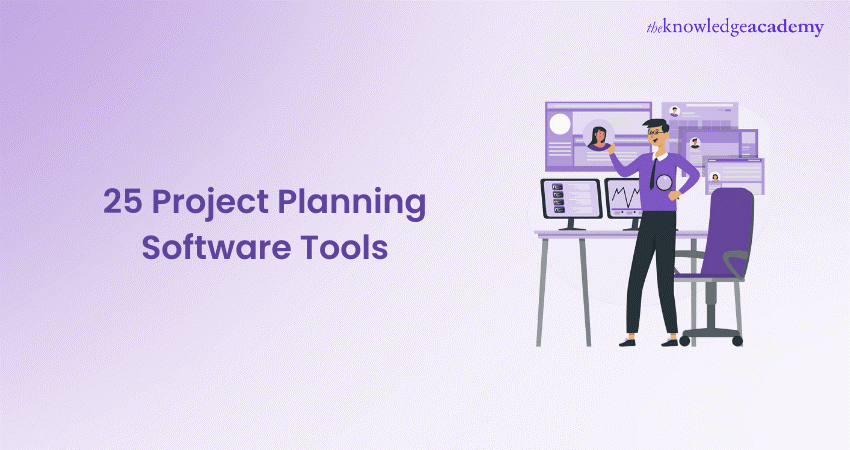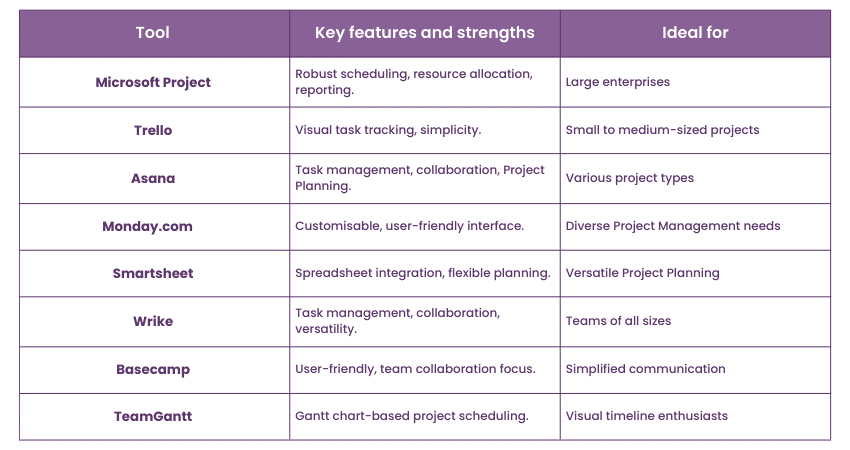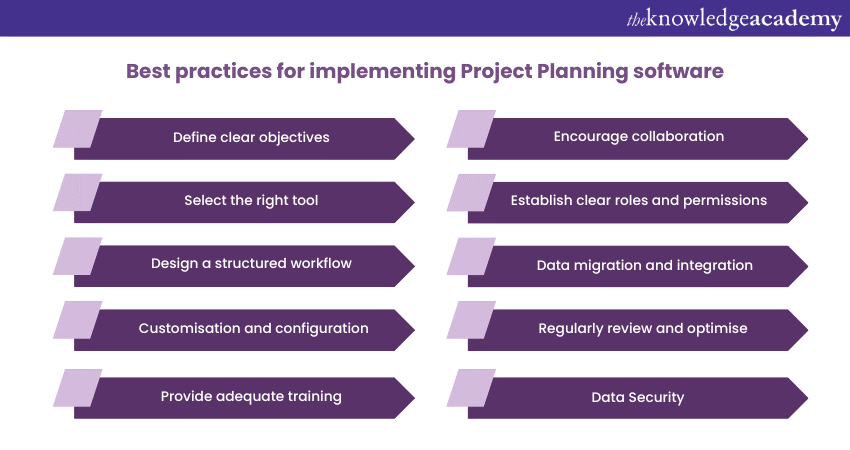We may not have the course you’re looking for. If you enquire or give us a call on 01344203999 and speak to our training experts, we may still be able to help with your training requirements.

close
Press esc to close

close


Press esc to close

close
Fill out your contact details below and our training experts will be in touch.



Back to Course Information
We ensure quality, budget-alignment, and timely delivery by our expert instructors.

Project Planning Software tools have become indispensable for modern project managers and teams, revolutionising the way projects are conceived, executed, and monitored. It simplifies the process of creating and managing project plans.
Key considerations when choosing the right project planning tool include project size and complexity, team collaboration needs, customisation options, and integration capabilities. Here are some popular Project Planning Software tools: Microsoft Project, Asana, Trello, Wrike, Notion, Jira, ClickUp, Airtable, and Smartsheet, etc. Read more!
Table of Contents
1) Top 25 Project Planning Software Tools
a) Microsoft Project
b) Trello
c) Asana
d) Monday.com
e) Smartsheet
f) Wrike
g) Basecamp
h) TeamGantt
i) ClickUp
j) Jira
2) Factors to consider when making your choice
3) Best practices for implementing Project Planning software
4) Conclusion
Project Planning software tools have revolutionised the way organisations and teams manage projects of all sizes and complexities. These Software tools provide a variety of features to help plan, execute, and monitor projects efficiently. Here, we will discuss the top 25 Project Planning tools available today.
Microsoft Project is a powerhouse project management tool trusted by large enterprises. It excels in scheduling, allowing project managers to create intricate project plans with task dependencies and timelines. With efficient resource allocation and reporting features, it ensures projects stay on track and within budget. Its integration with Microsoft Office apps streamlines collaboration.
It empowers project managers to create detailed project plans, defining tasks, dependencies, and timelines with precision. This level of detail ensures that project activities are well-structured and sequenced, minimising potential delays. However, it can be complex for beginners, and its cost may be prohibitive for small businesses.
Trello is a renowned Project Planning tool for its simplicity and visual approach to task management. Using Kanban boards offers an intuitive way to track tasks and project progress. It's user-friendly and suitable for teams of all sizes. While it excels in visual task tracking, Trello may lack advanced Project Planning features, making it better for smaller, less complex projects.
Collaboration is another key strength of Trello. Team members can easily assign tasks, add due dates, attach files, and engage in discussions within cards, fostering efficient communication and teamwork.
Asana is a versatile Project Planning tool that combines Project Planning, task management, and collaboration tools. It's adaptable to various project types and sizes. With strong task management features and user-friendly interfaces, it encourages team collaboration. However, its advanced features might be overwhelming for simple projects.
It provides an efficient and intuitive interface for creating, assigning, and tracking tasks. This feature allows teams to break down projects into manageable tasks, ensuring that everyone is aligned and focused on the work at hand.
Known for its customisability, Monday.com can be tailored to fit diverse project management needs. Its user-friendly interface simplifies task tracking and team collaboration. The tool is highly adaptable, making it suitable for various industries. However, its pricing may be a consideration for smaller businesses.
The user-friendly interface of the project planning tool simplifies project management, making it easily accessible to users with different levels of technical proficiency. The drag-and-drop functionality, intuitive visual elements, and straightforward design contribute to an efficient user experience.
Smartsheet combines spreadsheet functionality with project management tools, offering flexibility in Project Planning and execution. With Gantt charts, resource management, and collaboration features, it caters to a broad audience. Its spreadsheet-like interface can be both a strength and limitation, depending on user preferences.
Collaboration is another area where Smartsheet excels. Teams can collaborate on sheets in real-time, allowing for discussions, file attachments, and data updates. This fosters efficient communication and teamwork among project members.
Wrike is a Project Planning tool praised for its task management and collaboration capabilities. It suits teams of all sizes, offering a range of features to streamline project workflows. It excels in facilitating team alignment and communication. However, its extensive feature set may require some learning for full utilisation.
One of Wrike's notable strengths is its task management functionality. It excels in helping users create, assign, and track tasks with ease. This feature is valuable for breaking down complex projects into manageable parts and ensuring that team members stay organised and aligned with project objectives.
Basecamp is a Project Planning tool focused on team collaboration and communication. It simplifies task management and project discussions. While it's excellent for communication, it may lack the advanced Project Planning features needed for complex projects.
It simplifies task management, project discussions, and file sharing, making it accessible to users with varying levels of technical expertise. This ease of use is particularly valuable for teams looking to get started quickly without the need for extensive training. Therefore, it is often better suited for smaller projects for task management and communication
TeamGantt is a Project Planning tool that centres its approach around Gantt charts, providing users with a visually intuitive timeline for managing projects. This focus on visual representation makes it particularly appealing to those who prefer a clear, structured overview of their project's progress and dependencies.
With TeamGantt, tasks and their interdependencies are easily graspable, simplifying the complexities of project scheduling. This visual clarity is especially beneficial for project managers and teams looking for a straightforward, accessible way to monitor project timelines.
ClickUp offers a comprehensive platform with project management, time tracking, and goal-setting features. Its versatility makes it adaptable to different project types and industries. However, its extensive feature set might require some customisation to fit specific project needs.
One of ClickUp's strengths lies in its ability to facilitate team collaboration and coordination. It provides tools for creating, assigning, and tracking tasks, along with features for setting milestones and defining dependencies between tasks.
Elevate your Projects with our Project Planning And Control™ (PPC) Foundation Course – plan, execute, and succeed!
Originally designed for software development, Jira has expanded its use to various project management scenarios. It's particularly popular among Agile teams. However, its steep learning curve and focus on technical aspects may not suit all project types.
LiquidPlanner is a Project Planning tool known for its dynamic scheduling and resource management capabilities, making it a perfect choice for managing complex projects. It uses a unique approach that takes uncertainty and resource availability into account, providing realistic project timelines. However, its advanced features may be overkill for simpler projects.
MeisterTask offers an intuitive Kanban-style task management experience. It's suitable for small to medium-sized projects, providing efficient task tracking and collaboration tools. While it excels in simplicity, it may lack some of the advanced Project Planning features found in more comprehensive solutions.
GanttPRO focuses on Gantt chart-based Project Planning tool, simplifying project scheduling and visualisation. It's a user-friendly tool for creating and managing project timelines. However, it may have limitations in terms of collaboration and advanced project management features.
The tool is particularly beneficial for those who prefer a visual representation of project tasks, dependencies, and timelines. GanttPRO enables users to create, edit, and track tasks with ease, offering a clear overview of project progress.
Take control of your Projects with our Project Planning And Control™ (PPC) Foundation And Practitioner Course – elevate your planning and control skills!
Part of the Zoho suite, Zoho Projects offers a comprehensive set of project management features. It's known for its integration capabilities, allowing for seamless collaboration and data sharing across various applications. However, its extensive feature set may require some learning to fully utilise.
Hive is a user-friendly Project Planning tool with a visually appealing interface. It facilitates team collaboration through task assignments, file sharing, and communication tools. Its ease of use and versatility make it suitable for different industries and project sizes.
ProWorkflow excels in task management, time tracking, and reporting, making it a valuable tool for small to medium-sized teams. It simplifies project management processes and offers user-friendly features. However, it may not have the advanced capabilities required for complex projects.
OpenProject is an open-source Project Planning tool that covers Project Planning, issue tracking, and document management. It's a cost-effective choice for organisations seeking comprehensive project management features without the price tag of proprietary software.
One of OpenProject's notable strengths lies in its capability to cover a wide spectrum of project management needs. It includes Project Planning, issue tracking, document management, and even time tracking. This makes it suitable for various industries and project types, from software development to construction and beyond.
GanttProject is a free and open-source solution for Project Planning Software with Gantt charts. It's ideal for small projects with basic planning needs. While it lacks some advanced features, it's a budget-friendly option for simple project management.
The tool's central feature is its Gantt chart functionality, which allows users to create and visualise project timelines, set task dependencies, and allocate resources. This makes it suitable for straightforward project scheduling and tracking. GanttProject's simplicity is one of its key strengths, making it accessible to users with different kinds of technical expertise.
Taiga is designed for Agile teams and offers features like sprint planning, user stories, and backlog management. It's a suitable choice for organisations following Agile methodologies, providing the necessary tools for effective project management.
One of Taiga's standout strengths is its adaptability to Agile workflows, allowing teams to embrace Agile principles seamlessly. The tool facilitates collaboration among team members, making it easier to manage tasks, catch up with progress, and communicate effectively.
Redmine is an open-source project management tool known for issue tracking, document management, and version control. It's particularly popular in software development projects. Its flexibility and cost-effectiveness make it a valuable choice for some organisations, especially those with technical backgrounds.
One of Redmine's key strengths is its issue-tracking capabilities, which allow teams to log and manage project-related issues, bugs, and tasks efficiently. It also offers document management and version control features, enhancing collaboration and ensuring that teams have access to the latest project documentation.
Toggl Plan is an ideal choice for Agile project management. It offers intuitive visuals and collaboration features, simplifying Project Planning and execution for teams that follow Agile methodologies. It promotes transparency and flexibility in project workflows.
Toggl Plan also excels in team collaboration and communication. It offers features for assigning tasks, setting due dates, and attaching files, enabling teams to work cohesively regardless of their physical locations.
Primavera P6 is a heavyweight Project Planning tool often used for large-scale construction and engineering projects. It's renowned for its advanced scheduling and resource management capabilities. However, its complexity and cost make it best suited for enterprise-level projects.
One of Primavera P6's key strengths is its ability to create project schedules that take into account task dependencies, resource allocation, and constraints. This enables project managers to develop precise timelines and allocate resources efficiently. It remains the tool of choice for industries where detailed Project Planning and resource management are paramount.
Merlin Project is a Mac-focused project management tool with a strong emphasis on scheduling and resource management. It caters to users who prefer the macOS environment and offers features for managing complex projects efficiently.
Its key strength is its advanced scheduling capabilities, which allow project managers to create detailed project plans with task dependencies and timelines. Its user-friendly interface on macOS devices ensures a seamless user experience for Apple enthusiasts. The tool also excels in resource management, aiding in the efficient allocation and tracking of project resources.
Designed for enterprise-level projects, Sciforma offers advanced resource management, portfolio management, and reporting capabilities. It's a robust solution for organisations with complex project portfolios and a need for comprehensive project insights.
This Project Planning software’s extensive feature set and advanced capabilities may be overkill for smaller organisations or projects with straightforward requirements. It is best suited for large enterprises and organisations seeking comprehensive project and portfolio management solutions to manage complex projects and maximise resource efficiency.
LiquidPlanner, previously mentioned, is renowned for its dynamic scheduling. In addition to its scheduling strengths, it also offers robust resource management features, making it a valuable choice for organisations with fluctuating workloads and resource allocation needs.
Resource management is another area where LiquidPlanner excels. It allows organisations to allocate and manage resources efficiently, taking into consideration team member workloads and availability. This is particularly valuable for projects with fluctuating workloads or where resource allocation plays a critical role.

When selecting the right Project Planning software for your specific needs, several critical factors should be considered to make an informed choice:
a) Project size and complexity: Determine the size and complexity of your projects. Some tools are better suited for smaller, straightforward projects, while others excel in handling large-scale, complex endeavours.
b) Industry and project type: Consider your industry and the type of projects you undertake. Some software tools are tailored for specific industries or project methodologies, such as Agile or construction.
c) Team size and collaboration needs: Assess the size of your team and their collaboration requirements. Choose a tool that facilitates effective communication and teamwork, whether your team is small or dispersed.
d) User-friendliness: Evaluate the user-friendliness of the software, especially if you anticipate team members with varying levels of technical expertise. A user-friendly interface can streamline onboarding and adoption.
e) Customisation and flexibility: Determine the level of customisation and flexibility you need. Some tools allow extensive customisation to adapt to your unique project processes.
f) Resource management: If resource allocation is critical, opt for software with strong resource management features. This is essential for tracking and optimising resource allocation.
g) Budget: Consider your budget constraints. Some tools are cost-effective or offer free versions for small teams, while others are more suitable for enterprise-level projects with larger budgets.
h) Integration capabilities: Assess integration capabilities, especially if you rely on other software applications. Ensure that your chosen tool can integrate seamlessly with existing systems.
i) Reporting and analytics: If you require advanced reporting and analytics, select a tool that offers robust reporting features to monitor project progress and performance.
j) Scalability: Think about future growth. Select a tool that can scale with your organisation and accommodate evolving project management needs.
Implementing Project Planning tools effectively is crucial to maximise its benefits and enhance your project management processes. Here are some best practices to consider when implementing Project Planning software:

a) Define clear objectives: Clearly outline your objectives and goals for implementing the software. Identify the specific challenges you aim to address and the improvements you expect to see in your project management workflows.
b) Select the right tool: Ensure that the software you choose aligns with your project requirements, team size, and industry. Thoroughly research and test different options to select the most suitable tool.
c) Design a structured workflow: Develop a well-defined project management workflow that aligns with your organisation's processes. Ensure that the software supports this workflow and makes it easy for teams to follow.
d) Customisation and configuration: Tailor the software to your needs by configuring it to match your project management processes. Customise fields, templates, and notifications to align with your workflow.
e) Provide adequate training: Invest in training sessions for your team members to make sure they are proficient in using the software. Training can significantly reduce the learning curve and increase adoption rates.
f) Encourage collaboration: Emphasise the collaborative features of the software. Encourage team members to use the tool for communication, file sharing, and task assignment, fostering collaboration within the platform.
g) Establish clear roles and permissions: Define user roles and permissions within the software to ensure that team members have the appropriate access levels. This helps maintain data security and accountability.
h) Data migration and integration: If transitioning from another system, plan for data migration to ensure a smooth transition. Additionally, integrate the software with other relevant tools to streamline data sharing and reporting.
i) Regularly review and optimise: Continuously monitor how the software is being used and gather feedback from users. Regularly review your processes and adapt them based on insights gained from the software's analytics.
j) Data Security: Prioritise data security and implement necessary measures to protect sensitive project information. Ensure that the software complies with your organisation's security policies.
k) Change management: Plan a change management strategy to help employees adapt to the new software. Communicate the benefits and provide support to address any resistance to change.
l) Project governance: Establish project governance practices within the software, including project roles, responsibilities, and decision-making processes.
m) Documentation and training resources: Create documentation and training resources materials, such as user guides and tutorials, to support ongoing learning and help users troubleshoot issues independently.
n) Feedback loop: Maintain an open feedback loop with users to gather insights on their experience with the software. Use this feedback to make continuous improvements.
o) Regularly update and stay informed: Keep the software up to date with the latest versions and features. Stay informed about software updates and enhancements to leverage new functionalities.
The adoption of Project Planning Software tools has become an important component of modern project management. These tools empower organisations and teams to enhance collaboration and improve overall project success. By incorporating these Project Planning tools into their project management processes, organisations can achieve greater efficiency, transparency, and control over their projects.
Master the art of using Project Planning software – lead your Projects to success with our expert Project Planning and Control™ courses!
Date
 Project Planning and Control™ (PPC) Foundation and Practitioner
Project Planning and Control™ (PPC) Foundation and Practitioner
Mon 15th Jan 2024
Mon 6th May 2024
Mon 12th Aug 2024
Mon 28th Oct 2024